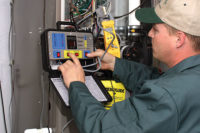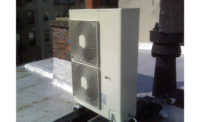
Dale Green
PENDING REGULATIONS
New regulations traditionally provide a market demand that is then met by the industry’s manufacturers. With federal energy regulations and mandates, manufacturers are able to meet these demands fairly easily and without inflicting hardship on themselves or the consumer. As state regulations continue to pop up across the country, however, meeting continually diverse market demands can create complex situations for the manufacturer.Although every manufacturer is committed to providing cost-effective solutions to each situation that arises, many agree that a single federal standard is the most advantageous route for all parties involved.
“A single federal standard takes into account all relevant factors, including technology, environmental impact, distribution feasibility, and consumer cost,” said Dale Green, vice president, sales, Trane, American Standard Heating and Air Conditioning, Tyler, Texas. “We believe that voluntary programs providing incentives to go beyond this balanced federal standard have proven to be very successful without unduly burdening consumers for whom it does not make sense economically or geographically.”
Uponor Inc.’s Culp agreed that federal standards were a better option for the industry.
“We think it would be to everyone’s benefit if there were more consistency and harmonization of the various initiatives. Although climate-zone effects, regional construction practices, and local demographics have to be considered, we would hope that a national consensus emerges.”
“Government regulation will continue to be a major challenge and opportunity for manufacturers - both at the state and federal level,” surmised Armstrong. “The demands that the government will be making five years from now are most likely not even technically possible today. So vigilance is the rallying cry regarding regulation.”

Andy Armstrong
Andy Armstrong, director of marketing for Johnson Controls Inc., Unitary Products Division, Milwaukee, acknowledged that the shifts in markets often shift sales.
“As happens so often in business, when one door closes, another opens,” he said. “The downturn has certainly presented a decrease in opportunities with the new construction market, while the residential replacement segment has shown strength.”
Both manufacturers, among others, are combating the uncertainty of the residential and commercial sectors by releasing new products designed to fit the specific subsectors of the market that are still experiencing or beginning to experience success.
“Our company has always been clearly focused on serving all segments of the residential market,” pointed out Clark. “The Goodman brand recently introduced a light commercial line of products, and we are continuing to introduce this complete product line through 2009.”
Johnson Controls’ recent product introductions to the shifting markets “have been well-received, especially in the replacement market,” said Armstrong. “What’s more, all of our condensing furnaces meet the new federal tax credit requirements.”
BUILDING MARKETS
Since the residential housing market began experiencing dropping numbers in 2006, it was the commercial construction market that made up for the loss as it experienced considerable growth and record-breaking numbers in 2007. The balance, however, was no longer held firm by the commercial market in 2008 and a cooling effect continued to deter both markets into 2009.According to Gary Clark, senior vice president of marketing for Goodman Global Inc., Houston, “The downturn in residential new construction has affected the entire cadre of HVAC manufacturers. We believe that the new construction commercial marketplace, along with the commercial replacement marketplace, will be affected by the severity of the economic downturn facing North America.”

Rob Goodfellow
GREEN TRENDS
Volatile markets aren’t new to manufacturers, and beyond creating new products, some manufacturers are capitalizing on niche markets. The IAQ and green markets, for example, offer new revenue streams that are affected differently by each market shift. Dynamic Air Quality Solutions in Princeton, N.J., is focused on providing IAQ options on various fronts.“Our niche is in providing IAQ options that can be installed quickly and easily on any call, not just when indoor units are being replaced,” said Rob Goodfellow, director of sales and marketing, Dynamic Air Quality Solutions. “On the residential side of our business, we offer IAQ products and training that contractors can use to increase ticket price and gross margin.”
On the commercial side, Duke Wiser, president of Dynamic Quality Air Solutions, noted that the middle of 2008 had slowed but that currently the company was, “busier than ever.”
“Because our commercial and industrial systems require less energy and less maintenance than conventional systems, we expect to be specified more in the kind of LEED and institutional projects that are moving forward in the current environment,” he said.
Uponor Inc., Apple Valley, Minn., considers the green movement to be a “bright spot” in the construction market, too.
“We have seen considerable growth in the commercial market for radiant heating and radiant cooling,” noted Joel Culp, vice president of marketing and offerings, Uponor Inc. “Much of this is attributable to sustainable (green) building practices that require the lower energy consumption and improved thermal comfort that can be provided by radiant heating and cooling systems.”

Gary Clark
ECONOMIC QUESTIONS
Having been signed into law in mid-February, the American Economic Recovery and Reinvestment Act of 2009 has the potential to change every industry included within its text.“We are cautiously optimistic the stimulus package will help,” noted Bill Hanesworth, vice president and general manager, Heating and Cooling Division, Rheem Manufacturing Co., Fort Smith, Ark. “Clearly the tax credits combined with utility incentives and manufacturers sales promotions will drive sales of high-efficiency products. However, the key issue will continue to be the ability of homeowners to obtain financing, as more than 70 percent of all HVAC systems are financed.”
Richard Fletcher, brand marketing manager, Carrier Corp., Indianapolis, agreed that the package would help improve the payback story being told to consumers.
“This legislation is a win for consumers,” he said. “Adding our Cool Cash rebates, our 10-year limited warranty on new equipment, and the new tax credits for the installation of energy-efficient equipment, there has never been a better time for consumers to replace old systems or upgrade to a more energy-efficient system.”
In hopes that the tax credits will provide a push for consumers still hesitant to make the investment in energy-efficient upgrades, manufacturers agree that the stimulus package has the potential to be important for the industry. Armstrong cautioned the industry to make sure, “our industry gets our share.”
“On the residential side, traditionally, we as an industry have been less aggressive than some of the other home efficiency improvement options available in the tax credit program,” he warned. “In the commercial sector, the focus on projects should be very good for our industry and as that sector slows, this stimulus could not have come at a better time.”
FACING THE FUTURE
Looking forward to the rest of 2009 and into the near future, the landscape is unknown. An acquisition trend became more prominent in 2008 and manufacturers are expecting this trend to grow in 2009.
Wiser summed it up when he said, “Nobody knows where the overall economy will be in five years, but we wouldn’t be surprised to see another round of acquisitions in the industry.”
“It is probable that a lot of merger and acquisition activity will be spurred by the current devaluation of many companies,” said Culp. “This could also lead to a highly altered competitive landscape, as the credit markets open and free up acquisition funds.”
The changing competition will create a new mix for manufacturers that will be especially noticeable when the economy begins to turn around. “Driving productivity will be essential to success,” said Green. “We believe that the markets will recover and when they do, the need to respond rapidly to increasing demand will be extremely important.”
Culp confirmed Green’s predictions as he discussed a need for companies to “try to rebalance their portfolios and respond to an evolving supply and demand scenario.”
As the Obama administration moves forward and continues to create new legislation, the environment is expected to be a driving factor across the nation.
“From efficiency to performance to packaging, we see the environment as very real and we must respect it as a company and as an industry,” said Fletcher.
“It also remains to be seen if the current economic crisis will have fundamentally altered how the American consumer makes investment decisions in the future, particularly as these changes relate to housing choices,” warned Culp.
To meet these new consumer mindsets and demands, manufacturers may find themselves searching for more innovative solutions.
“In the next five years, manufacturers will need to innovate,” said Fletcher. “Manufacturers need to provide integrated home solutions and new technologies to continue to satisfy the needs of customers.”
Publication Date: 03/23/2009
Wiser summed it up when he said, “Nobody knows where the overall economy will be in five years, but we wouldn’t be surprised to see another round of acquisitions in the industry.”
“It is probable that a lot of merger and acquisition activity will be spurred by the current devaluation of many companies,” said Culp. “This could also lead to a highly altered competitive landscape, as the credit markets open and free up acquisition funds.”
The changing competition will create a new mix for manufacturers that will be especially noticeable when the economy begins to turn around. “Driving productivity will be essential to success,” said Green. “We believe that the markets will recover and when they do, the need to respond rapidly to increasing demand will be extremely important.”
Culp confirmed Green’s predictions as he discussed a need for companies to “try to rebalance their portfolios and respond to an evolving supply and demand scenario.”
As the Obama administration moves forward and continues to create new legislation, the environment is expected to be a driving factor across the nation.
“From efficiency to performance to packaging, we see the environment as very real and we must respect it as a company and as an industry,” said Fletcher.
“It also remains to be seen if the current economic crisis will have fundamentally altered how the American consumer makes investment decisions in the future, particularly as these changes relate to housing choices,” warned Culp.
To meet these new consumer mindsets and demands, manufacturers may find themselves searching for more innovative solutions.
“In the next five years, manufacturers will need to innovate,” said Fletcher. “Manufacturers need to provide integrated home solutions and new technologies to continue to satisfy the needs of customers.”
Publication Date: 03/23/2009






